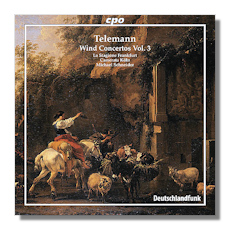
The Internet's Premier Classical Music Source
Related Links
- Telemann Reviews
- Latest Reviews
- More Reviews
-
By Composer
-
Collections
DVD & Blu-ray
Books
Concert Reviews
Articles/Interviews
Software
Audio
Search Amazon
Recommended Links
Site News
 CD Review
CD Review
Georg Philipp Telemann

Wind Concertos, Volume 3
- Concerto in D Major for Piccolo, Strings & Continuo, TWV 51:D4
- Concerto in C minor for Oboe, Strings & Continuo, TWV 51:c1
- Concerto in F Major for Recorder, Horn & Continuo, TWV 42:F14
- Concerto in G Major for Flute, Strings & Continuo, TWV 51:G2
- Concerto in D Major for Trumpet, Strings & Continuo, TWV 51:D7
- Concerto in G Major for 2 Transverse Flutes, Bassoon, Strings & Continuo, TWV 53:51
La Stagione Frankfurt, Camerata Köln/Michael Schneider
CPO 777268-2 DDD 54:09
Recorded over the course of five months, and with two different ensembles (not to mention three different recording engineers), you might worry that this CD would be a scattered affair. In fact, this CD is just further proof of Telemann's breadth as a composer, and it's a delightful program that is over too soon.
Telemann knew musical styles from all over Europe, many of them first-hand. The Piccolo Concerto begins with a movement in the Neapolitan style, and is followed by one with Polish elements. This concerto is unusual because the solo part is completely diatonic. Even so, it doesn't become monotonous or sound overly simplistic. Telemann also could compose in either a courtly or a rustic style. Movements fit for peasant dancing nearly rub shoulders here with graceful minuets. Also, Telemann could be uncomplicatedly cheerful or deeply melancholy; hear the opening of the Oboe Concerto for a chain of deep, heart-rending, and even mildly dissonant sighs.
Even Telemann the role model is represented here. The opening Andante of the Flute Concerto might sound very familiar, and if it does, that's because of its melodic similarity to the slow movement of Bach's Harpsichord Concerto in F minor, BWV 1056. In his booklet note, annotator Wolfgang Hirschmann suggests that Bach intentionally used the first part of Telemann's theme in his own concerto. (In those days, it wasn't considered stealing, because it was a common thing to do.)
There is sizeable overlap between the members of La Stagione Frankfurt and Camerata Köln, so perhaps it isn't even relevant to consider them as separate ensembles here. The former was founded and is conducted by Michael Schneider, who also plays the flute with the ensemble. Both groups play on period instruments or copies thereof, but there has been no compromising tonal quality. Schneider's tempos are good, and he is sensitive to Telemann's various styles and moods.
The sound has excellent warmth and presence.
Copyright © 2009, Raymond Tuttle




















